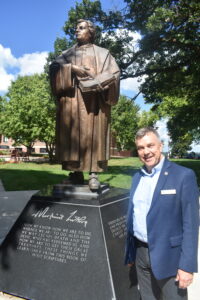Nikolaustag/St. Nicholas Day
As we begin yet another holiday season, many of us are filled with nostalgia, cheer, and perhaps a bit too much food. We reminisce about Christmases past, we revel in the traditions both new and generations-old, we complain about the snow while we marvel at its beauty, and we bask in the love of our friends and family. Though, a great many of us maybe don’t pay a second thought to where some of our long-held traditions come from, our ancestry in this region is still one of the most German around, as it happens. So, what better way to appreciate the season than by exploring the culture that so many of us are descended from?
I doubt that many would argue with me when I say that Christmas is the most famous holiday, Christian or otherwise, to be celebrated annually. Believers and non-believers alike take advantage of the season to spread goodwill, invest time on other important people in their lives, and consume the finest baked goods that their families have to offer. Now, Germans are no strangers to Christmas traditions, but they do take part in an extra festivity that we’re not always accustomed to celebrating here: Saint Nicholas Day, or Nikolaustag, which takes place on Dec. 6. Naturally, there are similarities and differences to our Christmas customs over here in the states, but what we don’t have in common is rather interesting.
It all begins on the eve of Dec. 5, when all the boys and girls begin preparing for Saint Nikolaus to visit. They polish their special boots, the Nikolaus-Stiefel, to set outside their doors, and hope for gifts and surprises from the saint. Much like our good buddy, Santa Claus, Saint Nikolaus is a fan of hiding gifts and candy in footwear. Similarly, if children are well-behaved, there is a certain level of positive reinforcement with the gifts, and Nikolaus rides through the streets on his horse, stopping to leave coins, toys, oranges, and other gifts for the good children whose names are written in his golden book.
If the children were naughty, however, they could expect bundles of birch sticks in their boots on the morning of the 6th, and in earlier, more extreme cases, Nikolaus’ companion Knecht Ruprecht would shake his sack of ashes at the children or hit them with a stick if they weren’t saying their prayers. In some southern regions of Germany and other German-speaking regions of Europe, the Krampus accompanies Nikolaus to punish the children who misbehave.
Now, normally this wouldn’t be so scary or bothersome, but the Krampus is a terrifying, demonic-looking beast that could strike fear into the hearts of just about anyone with misdeeds to hide from a gift-giving saint, and he would go so far as to occasionally swat the naughty children with birch sticks. So, naturally, this can be quite traumatic for some of the little ones, and it should come as no surprise that the tradition of having the Krampus walk the streets was banned at some points in history. It is interesting nonetheless, and it’s well worth it to watch a video of a Krampus walking the streets for a festival, as the tradition has made a comeback.
Now, I can only imagine that a lot of you are thinking, “So, Saint Nikolaus must be the German version of Santa Claus because we call Santa ‘St. Nick’, too.” Well, that’s not entirely wrong, but it’s not entirely correct either. Although these two men have similar habits in that they both reward and punish children in December, they are unique and exclusive people. Our idea of Santa Claus is much more similar to their idea of Father Christmas, or Weihnachtsmann. In fact, many religious families will remove the idea of Father Christmas completely and focus on Saint Nikolaus so that Christmas can remain a holiday focused on Jesus Christ instead of on the consumerism and materialism that we experience in America and in other Western countries.
To get a little more specific about Nikolaus, the date Dec. 6 is set aside to commemorate the death of the Bishop Nikolaus of Myra, who was originally a Greek Bishop who is now the patron saint of little children, among other things. If you see Nikolaus in advertisements in a modern setting, though, he bears a striking resemblance to our American Santa Claus, but it’s very likely that old perceptions of German pagan gods like Odin had distinct influence in determining his appearance in the cultural context. Not surprisingly, you’re also likely to see someone dressing as the old Saint, much like we see Santa’s imposters on our roofs and in our malls.
So, to wrap this up, I hope that you’ve found this little piece about our forefathers’ tradition to be an interesting one. I know that I enjoyed being able to talk to my German friends about their experiences with the holiday, and it was my distinct pleasure to write this for you all. I’d like to wish you all a Happy Nikolaustag, and just a reminder: Be good, and don’t forget to buy your Krampus-repellent.



